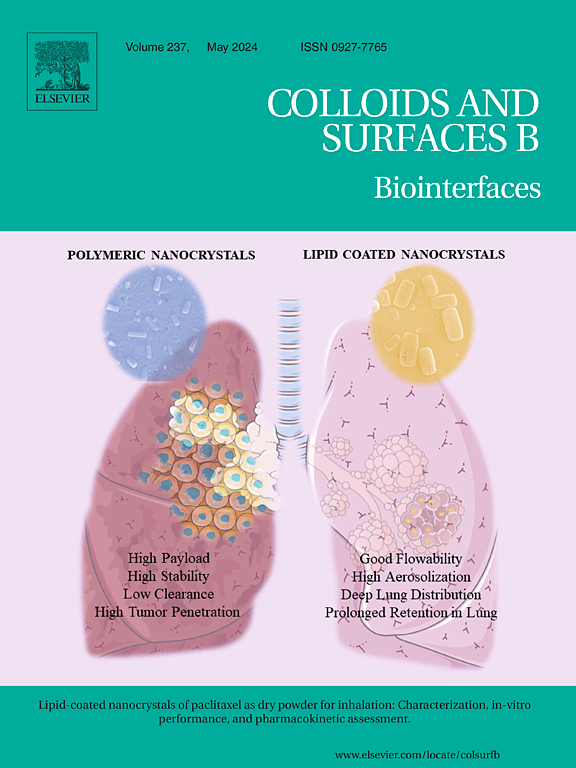构建掺碳铁基纳米酶,用于高效吸附和降解黄曲霉毒素 B1,从而协同去除黄曲霉毒素 B1。
IF 5.6
2区 医学
Q1 BIOPHYSICS
引用次数: 0
摘要
制备了具有优异吸附降解性能的多功能复合材料Fe3O4/GO/NH2-MIL-53(Fe),用于去除黄曲霉毒素B1(AFB1)。Fe3O4/GO/NH2-MIL-53(Fe)的吸附功能基于其较大的比表面积和丰富的吸附位点。Fe3O4/GO/NH2-MIL-53(Fe)的降解功能基于体系中金属离子与含氧基团配位形成的催化活性中心对 H2O2 的活化,产生羟基自由基(-OH)、超氧阴离子自由基(O2-)和单线态氧(1O2)。纳米酶的吸附加速了降解反应过程,随着降解过程的进行,吸附位点进一步暴露。这种协同效应实现了对 AFB1 的高效去除。Fe3O4/GO/NH2-MIL-53(Fe)作为掺碳铁基纳米酶的构建为 AFB1 的风险控制提供了新的去除方法。在吸附 AFB1 的同时,纳米酶的高级氧化作用也为降解 AFB1 提供了一条协同去除 AFB1 的可行途径。本文章由计算机程序翻译,如有差异,请以英文原文为准。
Construction of carbon-doped iron-based nanozyme for efficient adsorption and degradation to synergistic removal of aflatoxin B1
The multifunctional composites Fe3O4/GO/NH2-MIL-53(Fe) with excellent adsorption-degradation performance was prepared for the removal of Aflatoxin B1 (AFB1). The adsorption function of Fe3O4/GO/NH2-MIL-53(Fe) was based on the large specific surface area and abundant adsorption sites. The degradation function of Fe3O4/GO/NH2-MIL-53(Fe) was based on the activation of H2O2 by the catalytic active center formed by the coordination of metal ions and oxygen-containing groups in the system, resulting in hydroxyl radicals (·OH), superoxide anion radicals (O2-) and singlet oxygen (1O2). The adsorption of nanozyme accelerated the degradation reaction process, and the adsorption site was further exposed as the degradation process progressed. The synergistic effect realized the efficient removal of AFB1. Construction of Fe3O4/GO/NH2-MIL-53(Fe) as the carbon-doped iron-based nanozyme provided novel approaches of the removal for risks control of AFB1. Accompanied by the AFB1 adsorption, the advanced oxidation of nanozyme to the AFB1 degradation provided a promising way for the synergistic removal of AFB1.
求助全文
通过发布文献求助,成功后即可免费获取论文全文。
去求助
来源期刊

Colloids and Surfaces B: Biointerfaces
生物-材料科学:生物材料
CiteScore
11.10
自引率
3.40%
发文量
730
审稿时长
42 days
期刊介绍:
Colloids and Surfaces B: Biointerfaces is an international journal devoted to fundamental and applied research on colloid and interfacial phenomena in relation to systems of biological origin, having particular relevance to the medical, pharmaceutical, biotechnological, food and cosmetic fields.
Submissions that: (1) deal solely with biological phenomena and do not describe the physico-chemical or colloid-chemical background and/or mechanism of the phenomena, and (2) deal solely with colloid/interfacial phenomena and do not have appropriate biological content or relevance, are outside the scope of the journal and will not be considered for publication.
The journal publishes regular research papers, reviews, short communications and invited perspective articles, called BioInterface Perspectives. The BioInterface Perspective provide researchers the opportunity to review their own work, as well as provide insight into the work of others that inspired and influenced the author. Regular articles should have a maximum total length of 6,000 words. In addition, a (combined) maximum of 8 normal-sized figures and/or tables is allowed (so for instance 3 tables and 5 figures). For multiple-panel figures each set of two panels equates to one figure. Short communications should not exceed half of the above. It is required to give on the article cover page a short statistical summary of the article listing the total number of words and tables/figures.
 求助内容:
求助内容: 应助结果提醒方式:
应助结果提醒方式:


